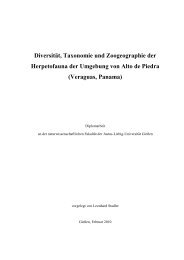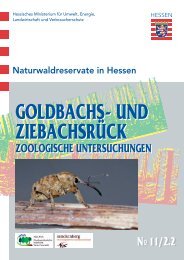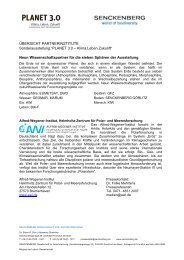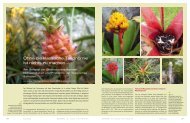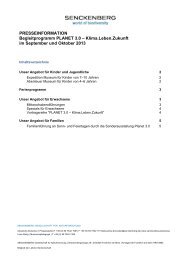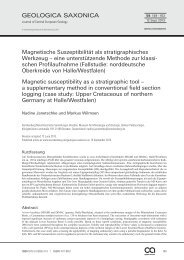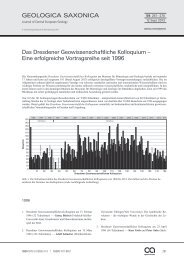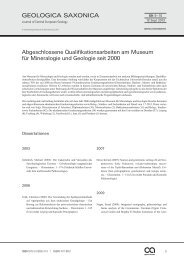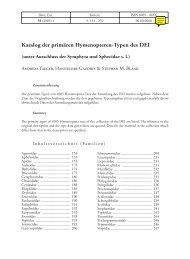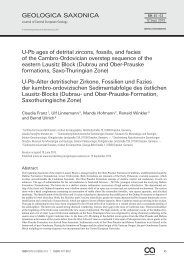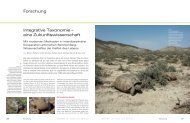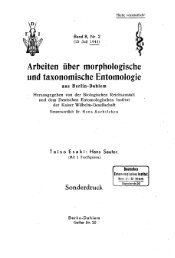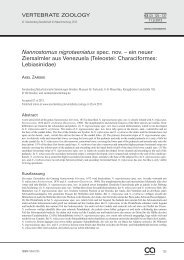Taxonomic publications: past and future - Senckenberg Museum
Taxonomic publications: past and future - Senckenberg Museum
Taxonomic publications: past and future - Senckenberg Museum
You also want an ePaper? Increase the reach of your titles
YUMPU automatically turns print PDFs into web optimized ePapers that Google loves.
Burckhardt & Mühlethaler (eds): 8 th GfBS Annual Conference Abstracts 22<br />
The potential of DNA barcoding with special reference to l<strong>and</strong> plants<br />
Robyn Cowan<br />
A wide range of molecular ‘fingerprinting’ techniques such as DNA sequencing,<br />
single nucleotide polymorphisms, nuclear <strong>and</strong> plastid microsatellites <strong>and</strong> amplified<br />
fragment length polymorphism, are used by biologists to study evolutionary<br />
relationships, species delimitation, hybridization <strong>and</strong> population dynamics. More<br />
controversially proposals have been made to base taxonomy “purely” on sequence<br />
data <strong>and</strong> molecular phylogenetic trees, for example the phylocode<br />
(http://www.ohiou.edu/phylocode/). They have also been used, albeit on an ad hoc<br />
basis, as a tool to aid species identification in situations where this is difficult because<br />
of a lack of morphological characters.<br />
The Consortium for the Barcode of Life (CBOL; http://www.barcoding.si.edu/) arose<br />
from discussions <strong>and</strong> meetings about the possibility <strong>and</strong> desirability of establishing a<br />
universal species level identification tool based on a short region of DNA sequence<br />
<strong>and</strong> the term ‘DNA barcoding’ was coined to describe this. The aims of CBOL are to<br />
develop ‘an accurate <strong>and</strong> reliable tool for scientific research on the taxonomy of plant<br />
<strong>and</strong> animal species, a practical, cost-effective tool for assigning unidentified<br />
specimens to their correct species, <strong>and</strong> a system for exp<strong>and</strong>ing interest <strong>and</strong> activity<br />
in taxonomy’.<br />
In a range of animal groups (<strong>and</strong> at least some algal groups), the mitochondrial<br />
cytochrome c oxidase subunit 1 gene (CO1 or cox1) is already proving to be<br />
efficacious as a DNA barcode although in some groups an additional or alternative<br />
region may be necessary. However this region is not suitable as a DNA barcode in<br />
l<strong>and</strong> plants as, with some exceptions, the rate of base mutations is too slow to<br />
distinguish between taxa at a species level. A project is underway to identify a plant<br />
DNA barcode that is as universal as possible across l<strong>and</strong> plants, whilst also providing<br />
a high rate of correct identification at the species level. Several c<strong>and</strong>idate regions will<br />
be tested on a range of densely sampled plant clades <strong>and</strong> protocols <strong>and</strong> primer<br />
information disseminated as widely as possible.<br />
Org. Divers. Evol. 5, Electr. Suppl. 13 (2005)



